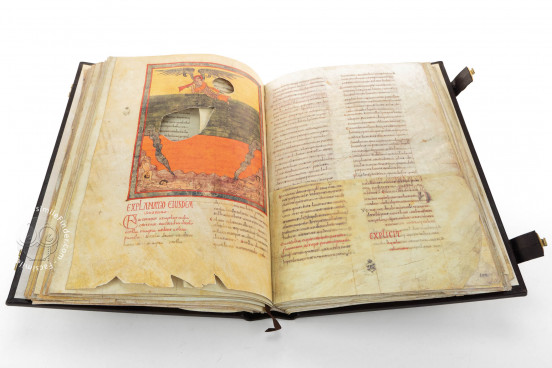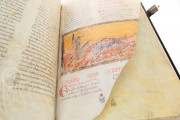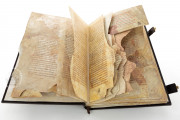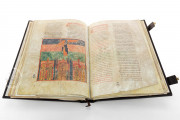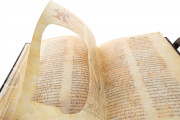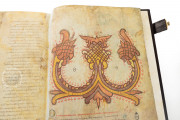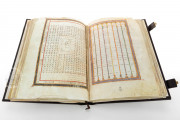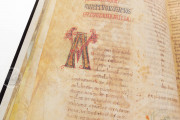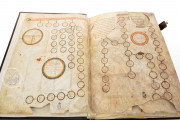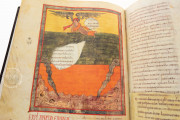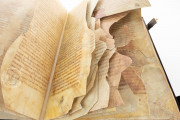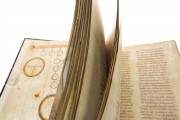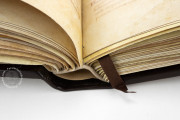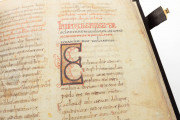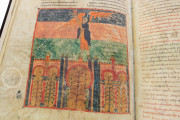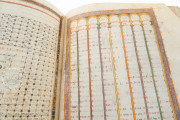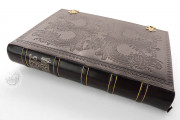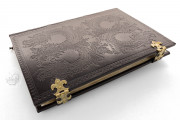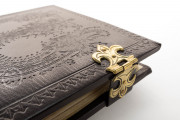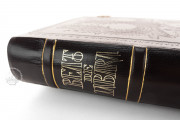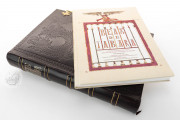Although only a few of its miniatures survive, the Tábara Codex is pivotal in our understanding of the tradition on the Iberian Peninsula of illuminated copies of the Christian biblical book of the Apocalypse with Beatus of Liébana's commentary. Created in the monastery of San Salvador de Tábara and completed in 970, it is remarkable above all for its extensive colophon and "portrait" of the monastic scriptorium. Together with the Girona Codex, it represents the apogee of the influence of Islamicate art on the illumination of Beatus manuscripts.
Surviving are three miniatures illustrating the Apocalypse (two of which are fragmentary), two miniatures illustrating a commentary on the biblical prophecy of Daniel by Saint Jerome, plus the famous miniature of Tábara's scriptorium and four pages of genealogical tables with painted bands.
The Earliest Depiction of a European Scriptorium
A full page is occupied by the representation of the monastery's bell tower, complete with a figure ringing the bells from street level (fol. 167v). Annexed to the tower's second story is shown a scriptorium (writing room) occupied by two scribes. One of the figures, distinguished by a tall cap, is labeled Emeterius, and the other, sitting on the opposite side of a shared writing table, is labeled Senior. In an adjoining room, an assistant is depicted cutting parchment with shears.
An Impressive Cast of Characters
The manuscript's colophon, situated under a large painted Greek letter omega with interlace knots, offers a wealth of information about its creation (fol. 167r). A certain Magius, identified as an archipictor (master-painter), was engaged in work on the manuscript until October 13, 968, just two weeks before his death. Emeterius, the author of the colophon and self-described pupil of Magius, completed the illumination over the course of three months in 970. Yet another participant in the manuscript's creation, one Monnius, declares that he was one of the scribes (fol. 166r).
Scholars have identified the writing on the first sixty-eight surviving leaves of the Tábara Codex as the work of Magius, who is identical to the Maius who created the Morgan Codex. Emeterius, whom scholars identify as responsible for all the surviving painted decoration, would again collaborate with the scribe Senior on the Girona Codex.
Inscriptions in Arabic
All four scribes wrote in Visigothic Minuscule, the medieval Latin script of the Iberian Peninsula. A few marginal annotations have been made in Arabic scripts, perhaps in the twelfth century.
A Second Life
A copy of the Tábara Codex, including the portrait of the Tábara tower with scriptorium, was made some 250 years after the manuscript's completion. That manuscript, known as the Las Huelgas Codex, was made either at the Castilian royal monastery of Santa María la Real de Las Huelgas or in the Castilian capital city of Burgos.
A Complicated History
The Tábara Beatus must have been wherever it was copied in the early thirteenth century. It has been conjectured that the codex was in Guadalupe in southwestern Spain between 1570 and 1770. It seems to have been in León in the second half of the nineteenth century, when it came into the possession of Ramón Álvarez de la Braña (1837-1906), from whom it was acquired by the Escuela Superior de Diplomática in Madrid, before entering the Archivo Histórico Nacional.
The manuscript was conserved and rebound in 1974. At that time, the pages of genealogical tables were moved to the front of the codex from their former position at the back. The collective illuminated codices of the Iberian Beatus tradition were placed on UNESCO's Memory of the World Register in 2015.
_____
For more information on the Beatus model, read our blog article by Amy R. Miller (PhD, Medieval Art History, University of Toronto).
We have 1 facsimile edition of the manuscript "Beatus of Liébana - Tábara Codex": Beato de Tábara facsimile edition, published by Testimonio Compañía Editorial, 2003
Request Info / Price
